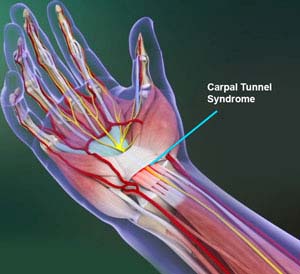
What is Carpal Tunnel Syndrome?
Carpal tunnel syndrome is a common, painful, progressive condition that is caused by compression of the median nerve at the wrist area. With carpal tunnel syndrome, the median nerve is compressed resulting in numbness, tingling and pain. Symptoms can occur in one or both hands. Nine tendons and one nerve (median) are contained within the carpal canal. The transverse carpal ligament forms the roof of the canal lying directly over the median nerve. This is the structure that is incised to release the compression on the nerve.
Symptoms of Carpal Tunnel Syndrome
The common symptoms of carpal tunnel syndrome include numbness and tingling sensation in the radial 3 1/2 digits (ie. thumb, index, long and radial side of the index) sparing the small finger and the ulnar aspect of the ring finger. In addition, pain and a burning sensation in the hand and wrist may radiate up the arm. Patients often report a sense of weakness in their hand with diminished grip strength that may result in the frequent dropping of items. Many people will shake out their hands to try to get rid of their symptoms. The symptoms often occur at nighttime but can also occur during the day with certain provocative activities which involve wrist flexion (eg. typing, driving and writing etc.).
At first, symptoms may come and go; as the condition progresses, the numbness may be present all the time. In addition, more advanced findings may include atrophy of the muscles that power the thumb (thenar atrophy). Dr. Miller will carefully determine the best course of treatment based on your history and physical exam findings. Patient education regarding the severity of the median nerve dysfunction is of utmost importance to set appropriate patient expectations.
Causes of Carpal Tunnel Syndrome
Although the exact cause is often unknown, certain factors increase the risk of developing carpal tunnel syndrome (pressure on the median nerve):
- The anatomy of your wrist
- Repetitive motion of hand and wrist
- Fractures and sprains
- Certain medical conditions
Diagnostic Tests for Carpal Tunnel Syndrome
Ultrasound is a non-invasive way to determine the presence of carpal tunnel syndrome. An enlarged nerve proximal to the transverse ligament along with a strong history and physical is often all that is required to determine the presence of carpal tunnel syndrome. Dr. Miller can perform the ultrasound exam at the time of your visit.
In cases where the diagnosis is not confirmed by the above or in the presence of atypical findings, an Electromyogram (EMG) and Nerve Conduction Study (NCS) may be ordered. These tests measure nerve and muscle function. These tests are an excellent way to determine the severity of the nerve compression as well as to rule out other potential entrapment points and/or the presence of peripheral neuropathy.
Conservative Treatment Options for Carpal Tunnel Syndrome
Conservative management of carpal tunnel syndrome may include:
- Treating the underlying medical condition(s)
- Immobilization of the hand and wrist with a splint or wrist brace for 4-6 weeks usually at night
- Rest the hand for 2 weeks or more
- Ergonomic adjustments at work (modify posture and work set up for computer use)
- Ice packs to avoid swelling
- Avoid activities that tend to worsen the symptoms
- Non-steroidal anti-inflammatory medications
- Strengthening and stretching exercises once symptoms diminish
- Ultrasound guided carpal tunnel injection
Carpal Tunnel Release Surgery
If conservative treatment options fail to resolve the condition, Dr. Miller may recommend surgery. Dr. Miller can perform this surgery under local anesthesia only, obviating the need for medical clearance and blood tests often required when sedation or general anesthesia is used. This has been very well received by patients. Carpal tunnel surgery involves an incision of up to 1-2 inches in the palm and wrist area. During the surgery, the transverse carpal ligament will be incised to release the pressure on the median nerve and enlarge the carpal tunnel. The success rate of this surgery is very high (over 90 percent). Symptoms that come and go will usually resolve very quickly, whereas long standing numbness or weakness can take many months to improve. Patients may improve for up to one year. Some nerve changes may be permanent and will remain even after a successful decompression of the carpal tunnel.
Postoperative Care for Carpal Tunnel Release Surgery
Your surgeon may suggest that you practice certain postoperative procedures for better recovery and avoid further complications.
- Elevate your hand above heart level to reduce swelling along with range of motion exercises of the fingers
- Ice packs to the surgical area to reduce swelling
- Keep the surgical incision clean and dry. Cover the area with plastic wrap when bathing or showering.
- Patients can resume near normal activities immediately with the exception of weight bearing or direct pressure over the surgical wound
Risks and Complications of Carpal Tunnel Release Surgery
Although very rare, possible complications may include continued pain and numbness, infection, wound dehiscence , and nerve injury. Scar sensitivity and pillar pain (pain on either side of the incision) which resolve in most cases within 3 months are possible. Massage of the incision site and tender areas is recommended.














